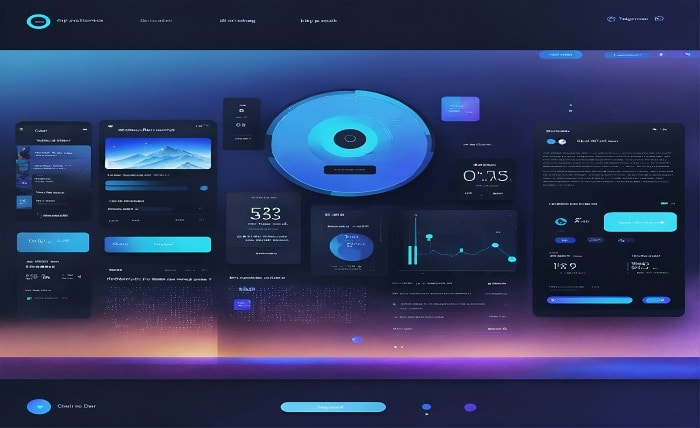The Ultimate Guide to Using a Light Blue Background in Design

Why Background Colors Matter
Have you ever landed on a webpage and instantly felt relaxed, focused, or even energized, just because of the background color? That’s no accident. Color plays a huge role in design psychology. Background colors influence mood, perception, and even usability. And among them, a light blue background stands out as one of the most effective.
The Rising Popularity of Light Blue Backgrounds
In recent years, light blue has won a reputation across digital structures. Whether you are scrolling through websites, flipping through shows, or designing a new app interface, you may have stumbled upon that soft, soothing hue. It’s now not just today’s—it’s useful, flexible, and effective.
Understanding the Psychology of Light Blue
The Emotional Impact of Light Blue
Light blue often inspires peace, trust, and serenity. It’s associated with clean skies and calm waters, triggering a tranquil attitude. When utilized in layout, it subtly encourages relaxation and consciousness, perfect for user retention.
Cultural Associations with Blue Shades
From corporate boardrooms to healthcare institutions, blue signifies professionalism, reliability, and calm in diverse cultures. Light blue tones are much less aggressive than darker blues, making them perfect for friendly, approachable branding.
Benefits of Using a Light Blue Background
Enhances Readability
A light blue historical past offers gentle assessment, particularly when paired with darkish grey or black textual content. This makes content material smooth on the eyes, even in the course of long reading periods.
Calms the Viewer
Designs that crush the senses don’t hold interest for long. Light blue helps tone matters down and makes your interface experience breathable and open.
Versatile for Any Theme
Whether you’re constructing a tech website, well well-being app, or a minimalist blog, light blue blends with diverse colour palettes and issues.
Where to Use Light Blue Backgrounds
Websites and Blogs
A mild blue history can decorate the consumer experience on:
User Interface Design
Buttons, cards, and sections with mild blue make layouts feel prepared and intuitive.
Landing Pages
Use light blue as a backdrop to direct attention to CTAs without overwhelming customers.
Social Media Graphics
In posts, commercials, or stories, a smooth blue heritage makes pix and textual content pop with subtlety, standing out without shouting.
Business Presentations
Impress your target market with slides which are professional but calming—a combo that light blue grants perfectly.
Posters and Print Media
In flyers and brochures, light blue makes your layout sense clean, easy, and current.
Design Tips for Light Blue Backgrounds
Best Font Colors to Pair With Light Blue
Stick with:
- Navy or charcoal gray for comparison
- White for soft elegance
- Dark, inexperienced, or muted pink for the accessory
Imagery and Icons That Work Well
Think of photographs with white borders, easy edges, and pastel tones. Avoid ambitious, oversaturated pictures that clash.
Using Gradients and Textures
Add diffused gradients (e.g., mild blue fading into white) or textures (like waves or clouds) to create intensity and visible hobby.
Light Blue Background in Web Design
UX and UI Benefits
Light blue reduces eye pressure, courses consciousness, and makes navigation intuitive. Users experience calm and are encouraged to live longer.
SEO Considerations
When users live longer on your page because of a pleasing interface, bounce rates drop—that may improve your search engine marketing rankings in a roundabout way.
Light Blue Backgrounds in Branding
Ideal for Corporate Identity
Companies in finance, tech, healthcare, and wellness industries regularly use light blue for its affiliation with balance and consideration.
Psychological Branding Power
It enables brands to appear approachable but capable, softening the company tone without losing credibility.
Light Blue Background Examples
Famous Websites Using Light Blue
- Twitter: Uses mild blue elements for branding
- Dropbox: Implements light blue in illustrations and interfaces
Template and Theme Examples
Look for issues on platforms like ThemeForest or Canva that use light blue as a base for portfolios, blogs, and business websites.
Common Mistakes to Avoid
Overusing Blue Tones
Too much blue makes designs feel bloodless or sterile. Balance with warm accents or impartial colours.
Poor Text Contrast
Avoid light gray or pastel fonts on light blue—it kills clarity. Stick with excessive-evaluation sun shades.
Tools to Create Light Blue Backgrounds
Canva
Free, amateur-pleasant, and best for short social pics.
Photoshop
Offers deep manipulation—add textures, shadows, and layered gradients.
Figma
Great for UI/UX layout teams working collaboratively on web/app projects.
Hex Codes and Color Variations
Popular Light Blue Hex Codes
- #ADD8E6 – Classic Light Blue
- #B3DDF2 – Soft Sky
- #D6F0FF – Icy Blue
- #E0F7FA – Cool Mist
Combining Light Blue With Other Colors
- Light blue + white = smooth and modern-day
- Light blue + military = robust and assured
- Light blue + peach or coral = warm and welcoming
Accessibility Considerations
Making Sure Your Design is Inclusive
Use evaluation checkers to make certain that mild blue backgrounds meet WCAG tips, especially for visual impairments.
Light Blue in Dark Mode vs Light Mode
While mild blue thrives in mild mode, in dark mode it can seem washed out—choose deeper blues or soft gradients as a substitute.
Light Blue in Mobile Design
App Backgrounds
Perfect for onboarding screens, settings, and chat UIs wherein a calm layout enhances focus.
Notifications and Cards
Helps spotlight information without feeling too alarming, perfect for subtle reminders or tooltips.
Trends in Light Blue Design
2024 and Beyond
Expect to peer at neo-minimalist design, with mild hues like mild blue taking the middle stage.
Minimalism and Soft Palettes
Designers are moving in the direction of low-stimulation, emotionally sensitive interfaces, and light blue is a key player.
Conclusion
Incorporating a light blue heritage into your layout isn’t only a visual choice—it’s a strategic pass that affects user experience, emblem perception, and emotional engagement. Whether you’re designing a website, app, presentation, or promotional fabric, light blue serves as a dependable, stylish, and present-day foundation. Pair it smartly, use it purposefully, and watch your designs breathe with readability and self-belief.





